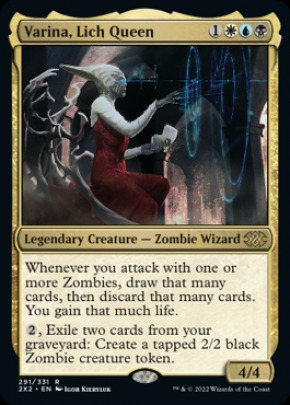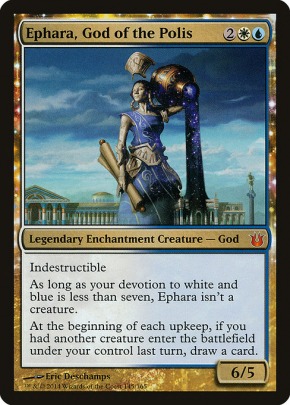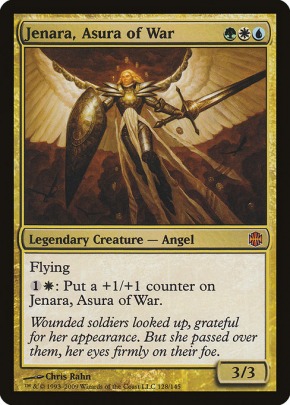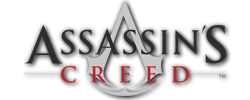Terror
When instants and sorceries resolve, they typically resolve left to right, unless they specify otherwise or some weird edge cases are in play.
Given that being the general rule, I'm not sure why the way Terror and other removals that prevent regeneration work. From a purely logical, if not intuitive, angle, you'd expect the regenerating creature to be attempted to be removed first as the instant is resolving, *then* for the destruction to be replaced by the replacement effects from regeneration, *then* for the inability to regenerate them to take effect. I understand that this is NOT how Terror works, I understand that the Albino Troll WILL die even if its ability is activated in advance, but I don't get why Terror isn't worded the other way around to clarify. As in: "Target nonartifact, nonblack creature can't be regenerated this turn. Destroy it."
EDIT: To be clear, I do understand why cards like Incinerate are properly formatted. Unlike Terror, Incinerate kills after the spell resolves, not during the resolution, so the order of resolution doesn't matter there.
The Templating of Terror-like Cards
Accepted Answer
Rule 608.2c explains why they work:
As to why they are worded this way it can be assumed that Wizards thinks they read better this way. It is also important to note that this isn't a situation of effects happening in the order they appear on the card. Rather there is one effect: "Destroy creature" and then a later clarification on what the effect can do. So the second sentence isn't its own effect. Rather it clarifies that the Destroy effect simply gets around Regeneration and the rule above is what allows it to function that way. The second example in that rule offers a situation where re-ordering the text doesn't make as much sense.
Go to full post608.2c. The controller of the spell or ability follows its instructions in the order written. However, replacement effects may modify these actions. In some cases, later text on the card may modify the meaning of earlier text (for example, "Destroy target creature. It can't be regenerated" or "Counter target spell. If that spell is countered this way, put it on top of its owner's library instead of into its owner's graveyard.") Don't just apply effects step by step without thinking in these cases--read the whole text and apply the rules of English to the text.
As to why they are worded this way it can be assumed that Wizards thinks they read better this way. It is also important to note that this isn't a situation of effects happening in the order they appear on the card. Rather there is one effect: "Destroy creature" and then a later clarification on what the effect can do. So the second sentence isn't its own effect. Rather it clarifies that the Destroy effect simply gets around Regeneration and the rule above is what allows it to function that way. The second example in that rule offers a situation where re-ordering the text doesn't make as much sense.
"Destroy target creature. It can't be regenerated." functions slightly differently from "Target creature can't be regenerated this turn. Destroy it."
Imagine the following sequence:
-a creature gains indestructible
-that creature is hit by a kill spell, templated as above
-after the spell resolves (and the creature doesn't die, because it is indestructible), Bonds of Mortality is activated to make it lose indestructible
-the creature gains a regeneration shield
-the creature is hit by Murder
In the first case, the destroy effect would be stopped by the regeneration shield - the 'it can't be regenerated' only applies to the initial kill spell. On the other hand, if the second version were used, preventing all regeneration, then the second kill spell would succeed and the creature would die.
As you've pointed out, Incinerate needs the 'can't be regenerated this turn' clause because the damage doesn't actually kill the creature - rather, state-based actions kill the creature after the spell resolves. However, destroy effects kill a creature directly, so 'can't be regenerated' is sufficient to cover the case - 'can't be regenerated this turn' is unnecessary. You could template a spell using the latter, but it would be unnecessary in the vast majority of cases (i.e. not the needlessly complicated case explained above). At that point, I would hypothesize that the former is used because it requires fewer words and reads cleaner.
Imagine the following sequence:
-a creature gains indestructible
-that creature is hit by a kill spell, templated as above
-after the spell resolves (and the creature doesn't die, because it is indestructible), Bonds of Mortality is activated to make it lose indestructible
-the creature gains a regeneration shield
-the creature is hit by Murder
In the first case, the destroy effect would be stopped by the regeneration shield - the 'it can't be regenerated' only applies to the initial kill spell. On the other hand, if the second version were used, preventing all regeneration, then the second kill spell would succeed and the creature would die.
As you've pointed out, Incinerate needs the 'can't be regenerated this turn' clause because the damage doesn't actually kill the creature - rather, state-based actions kill the creature after the spell resolves. However, destroy effects kill a creature directly, so 'can't be regenerated' is sufficient to cover the case - 'can't be regenerated this turn' is unnecessary. You could template a spell using the latter, but it would be unnecessary in the vast majority of cases (i.e. not the needlessly complicated case explained above). At that point, I would hypothesize that the former is used because it requires fewer words and reads cleaner.
Rule 608.2c explains why they work:
As to why they are worded this way it can be assumed that Wizards thinks they read better this way. It is also important to note that this isn't a situation of effects happening in the order they appear on the card. Rather there is one effect: "Destroy creature" and then a later clarification on what the effect can do. So the second sentence isn't its own effect. Rather it clarifies that the Destroy effect simply gets around Regeneration and the rule above is what allows it to function that way. The second example in that rule offers a situation where re-ordering the text doesn't make as much sense.
608.2c. The controller of the spell or ability follows its instructions in the order written. However, replacement effects may modify these actions. In some cases, later text on the card may modify the meaning of earlier text (for example, "Destroy target creature. It can't be regenerated" or "Counter target spell. If that spell is countered this way, put it on top of its owner's library instead of into its owner's graveyard.") Don't just apply effects step by step without thinking in these cases--read the whole text and apply the rules of English to the text.
As to why they are worded this way it can be assumed that Wizards thinks they read better this way. It is also important to note that this isn't a situation of effects happening in the order they appear on the card. Rather there is one effect: "Destroy creature" and then a later clarification on what the effect can do. So the second sentence isn't its own effect. Rather it clarifies that the Destroy effect simply gets around Regeneration and the rule above is what allows it to function that way. The second example in that rule offers a situation where re-ordering the text doesn't make as much sense.
-
Perrodequeso
- Posts: 6
- Joined: 4 years ago
- Pronoun: Unlisted
Something that hasn't been brought up is, Regeneration worked very differently during the early years of Magic. You couldn't just put up a regeneration shield any old time, you could only use regeneration after lethal damage was dealt or a destroy effect resolved. Things were awkward back then to say the least. Regeneration almost worked like a replacement effect in a way, once the creature was on it's way to the grave you would then use regeneration to stop that from happening.
I believe it was the Sixth Edition rules change that changed Regeneration to being used as a response put onto the Stack after the creature was targeted. And then some time later it was changed to it's current usage (the 2010 rules change?!?).
I believe it was the Sixth Edition rules change that changed Regeneration to being used as a response put onto the Stack after the creature was targeted. And then some time later it was changed to it's current usage (the 2010 rules change?!?).








